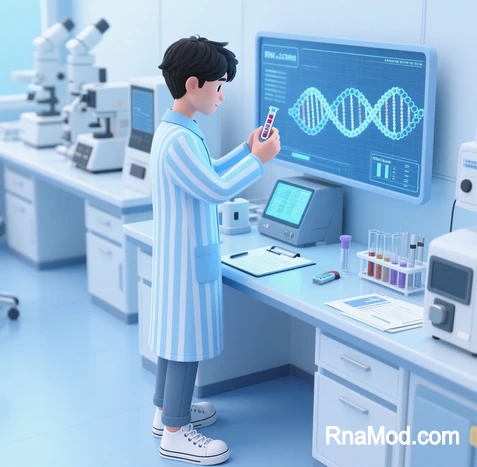 I. Foundational Definition: The Central Dogma’s First Act
I. Foundational Definition: The Central Dogma’s First Act
Transcription is the enzymatic process by which a specific DNA sequence is copied into a complementary RNA strand. As the initial step of gene expression, it enables cells to selectively access genetic instructions for protein synthesis, regulatory functions, and cellular adaptation. Unlike DNA replication, transcription generates single-stranded RNA molecules that serve as transient messengers (mRNA), catalytic agents (rRNA), or regulatory elements (miRNA/siRNA) without altering the genomic template (#user-content-fn-1)(#user-content-fn-3)(#user-content-fn-10).
(Fig. 1: The Transcription Workflow)
Description: DNA double helix unwinds at a gene locus. RNA polymerase (blue) synthesizes nascent RNA (red) complementary to the template strand. Transcription factors (yellow) bind promoter/enhancer sequences to regulate initiation.
II. Molecular Mechanics: Core Components & Principles
A. RNA Polymerase: The Molecular Scribe
RNA polymerase (RNAP) catalyzes template-directed RNA synthesis through:
- Template Strand Specificity: Reads the DNA template strand 3’→5’, polymerizing RNA 5’→3’ using ribonucleotides (ATP, GTP, CTP, UTP) (#user-content-fn-2)(#user-content-fn-10).
- De Novo Initiation: Requires no primer, unlike DNA replication (#user-content-fn-3)(#user-content-fn-9).
- Limited Proofreading: Higher error rates (~10⁻⁴) than DNA replication due to absent exonuclease activity (#user-content-fn-3)(#user-content-fn-15).
B. Strand Selectivity & Sequence Conservation
Only the template (antisense) strand is transcribed. The resulting RNA mirrors the non-template (sense) strand, with thymine (T) replaced by uracil (U) (#user-content-fn-2)(#user-content-fn-4).
(Fig. 2: Template vs. Non-Template Strand Dynamics)
Description: Template strand (dark blue) directs RNA synthesis. Non-template strand (light blue) shares sequence identity with RNA (red) except T→U substitution.
III. The Transcription Cycle: Stages & Mechanisms
A. Initiation: Precision Assembly
- Promoter Recognition: RNAP binds conserved promoter sequences upstream of genes (e.g., TATA box in eukaryotes; -10/-35 elements in bacteria) (#user-content-fn-6)(#user-content-fn-8)(#user-content-fn-13).
- Preinitiation Complex (PIC): Eukaryotes require general transcription factors (e.g., TFIID for TATA box binding) to recruit RNAP II (#user-content-fn-6)(#user-content-fn-13).
- Transcription Bubble Formation: Helicase activity (e.g., TFIIH) melts 14-17 bp of DNA, exposing the template strand (#user-content-fn-3)(#user-content-fn-10).
B. Elongation: Processive Synthesis
- Rate & Fidelity: Adds 40-80 nucleotides/sec with error rates minimized by kinetic proofreading (#user-content-fn-10).
- Topological Management: DNA supercoiling resolved by topoisomerases (e.g., gyrase in bacteria) (#user-content-fn-6)(#user-content-fn-15).
- Transient Hybridization: 8-9 bp RNA-DNA hybrid stabilizes the elongation complex (#user-content-fn-3)(#user-content-fn-10).
(Fig. 3: Transcription Bubble Architecture)
Description: RNAP (blue) encloses melted DNA. Nascent RNA (red) hybridizes transiently with template strand. Positive supercoils accumulate ahead of RNAP.
C. Termination: Programmed Cessation
| Type | Mechanism | Organisms |
|---|---|---|
| Rho-Dependent | Rho helicase disrupts RNA-DNA hybrid | Bacteria |
| Intrinsic | GC-rich hairpin + poly-U tract stalls RNAP | Bacteria/Archaea |
| Poly(A)-Coupled | CPSF/CstF cleavage triggers disassembly | Eukaryotes |
| Torpedo Model | Xrn2 exonuclease degrades RNA to displace RNAP | Eukaryotes |
IV. Biological Significance & Regulation
A. Gene Expression Gatekeeping
- Selective Activation: <0.1% of human genes are transcribed in a specific cell type at any time (#user-content-fn-5)(#user-content-fn-9).
- Regulatory Hierarchies: Transcription efficiency determines cellular protein abundance and function (#user-content-fn-11)(#user-content-fn-14).
B. Epigenetic Control Layers
- Chromatin Remodeling:
- Histone modifications (H3K4me3 = activation; H3K27me3 = repression) (#user-content-fn-7)(#user-content-fn-14).
- Nucleosome repositioning by SWI/SNF complexes (#user-content-fn-13).
- DNA Methylation: Hypermethylation of CpG islands silences promoters (#user-content-fn-14).
(Fig. 4: Eukaryotic Transcriptional Regulation)
Description: Chromatin loop (purple) brings enhancer (orange) to promoter-bound PIC. Histone modifications (green/red tags) modulate accessibility.
V. Evolutionary Conservation & Technological Applications
A. Domain-Specific Adaptations
| Feature | Prokaryotes | Eukaryotes |
|---|---|---|
| RNAP Complexity | Single multi-subunit complex | Pol I/II/III with specialized roles |
| Promoter Structure | -10 (TATAAT) / -35 elements | TATA box, BRE, DPE |
| Post-Transcriptional Processing | Minimal | 5’ capping, splicing, polyadenylation |
B. Biotechnology Innovations
- Engineered Promoters: T7 RNAP system drives high-yield recombinant protein production (#user-content-fn-10)(#user-content-fn-15).
- CRISPR-Activation (CRISPRa): dCas9-TF fusions enable programmable gene upregulation (#user-content-fn-8)(#user-content-fn-12).
Conclusion: The Dynamic Transcriptional Landscape
“Transcription is not molecular photocopying—it is the cell’s master control system for converting static genetic code into dynamic biological responses.”
— Molecular Biology Review
Future Frontiers:
- Single-Molecule Imaging (2026): Real-time observation of RNAP dynamics
- Epigenome-Guided Promoters (2028): Synthetic regulatory elements for precision medicine
Data sourced from publicly available references. For collaboration or domain acquisition inquiries, contact: chuanchuan810@gmail.com.
